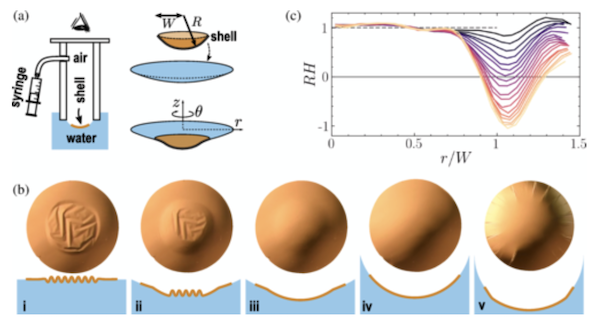Timounay, Y; Hartwell, AR; [...] Demery, V; Paulsen, JD
Phys. Rev. Lett. 127, 108002
10.1103/PhysRevLett.127.108002
 Thin elastic films can spontaneously attach to liquid interfaces, offering a platform for tailoring their physical, chemical, and optical properties. Current understanding of the elastocapillarity of thin films is based primarily on studies of planar sheets. We show that curved shells can be used to manipulate interfaces in qualitatively different ways. We elucidate a regime where an ultrathin shell with vanishing bending rigidity imposes its own rest shape on a liquid surface, using experiment and theory. Conceptually, the pressure across the interface "inflates" the shell into its original shape. The setup is amenable to optical applications as the shell is transparent, free of wrinkles, and may be manufactured over a range of curvatures.
Thin elastic films can spontaneously attach to liquid interfaces, offering a platform for tailoring their physical, chemical, and optical properties. Current understanding of the elastocapillarity of thin films is based primarily on studies of planar sheets. We show that curved shells can be used to manipulate interfaces in qualitatively different ways. We elucidate a regime where an ultrathin shell with vanishing bending rigidity imposes its own rest shape on a liquid surface, using experiment and theory. Conceptually, the pressure across the interface "inflates" the shell into its original shape. The setup is amenable to optical applications as the shell is transparent, free of wrinkles, and may be manufactured over a range of curvatures.

